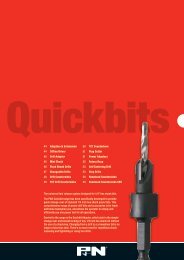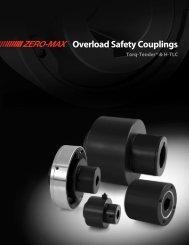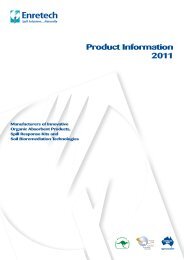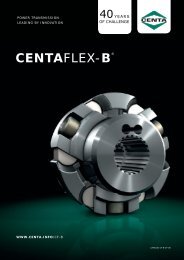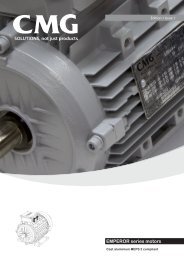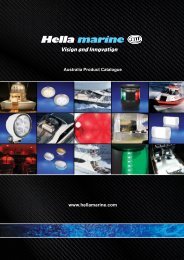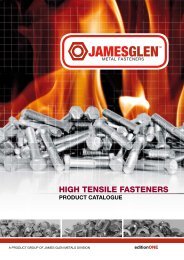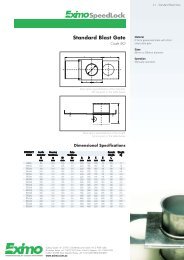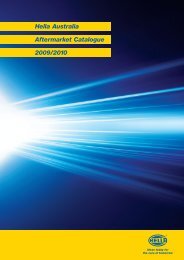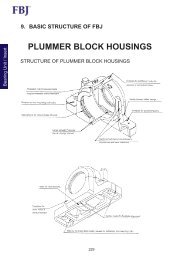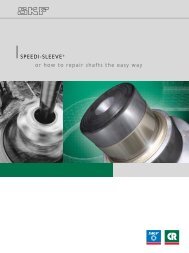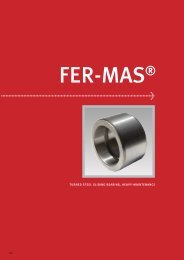Create successful ePaper yourself
Turn your PDF publications into a flip-book with our unique Google optimized e-Paper software.
SERIES XSELECTION PROCEDUREStandard Selection MethodThe standard selection method can be used for mostmotor, turbine, or engine driven applications. The followinginformation is required to select a gear coupling.• Kilowatt (kW) or torque (Nm).• Running rpm.• Application or type of equipment to be connected(motor to pump, drive to conveyor, etc.).• Shaft diameters.• Shaft gaps.• Physical space limitations.• Special bore or finish information and type of fit.Exceptions are High Peak Loads and Brake Applications.For these conditions, use the Formula Selection Methodin the next column, or consult one of our ApplicationEngineers for assistance.1. RATING: Determine system torque. If torque is notgiven, calculate as shown below.System Torque (Nm) = kW x 9549rpmWhere: kW (Kilowatt) is the actual or transmittedpower required by the application (if unknown, usethe motor or turbine nameplate rating) and rpm is theactual speed the coupling is rotating. Applications thatrequire rapid changes in direction or torque reversalsshould be referred to our Application Engineers.1. SERVICE FACTOR: Determine the appropriateservice factor from Table 1, Page 6.2. REQUIRED MINIMUM COUPLING RATING:Determine the required minimum coupling ratingas shown below Minimum Coupling Rating = S.F.(Service Factor) x Torque (Nm)3. SIZE: Turn to appropriate pages for the coupling typechosen and trace down the torque column to a valuethat is equal or greater than that determined in Step 3above. The coupling size is shown in the first column.4. CHECK: Check speed (rpm), bore, gap anddimensions.Formula Selection MethodThe Standard Selection Method can be used for mostcoupling selections. The procedure below should be usedfor:• High Peak Loads• Brake Applications (where the disc brake orbrakewheel is to be an integral part of the coupling,consult our Application Engineers for design options).Providing system peak torque and frequency, duty cycle, andbrake torque rating will allow for a more refined selectionusing the Formula Selection Method.1. HIGH PEAK LOADS: Use one of the followingformulas for applications using motors with torquecharacteristics that are higher than normal;applications with intermittent operations, shockloading, inertia effects due to starting and stoppingand or system induced repetitive high peak torques.System Peak Torque is the maximum torque that canexist in the system.Select a coupling with a torque rating equal to orgreater than selection torque calculated below.A. NON-REVERSING HIGH PEAK TORQUESelection Torque (Nm) = System Peak TorqueorSelection Torque (Nm) = System Peak kW x 9549rpmB. REVERSING HIGH PEAK TORQUESelection Torque (Nm) = 1.5 x System Peak TorqueorSelection Torque (Nm) = 1.5 x Peak kW x 9549rpmC. OCCASIONAL PEAK TORQUES (Non-Reversing)If a system peak torque occurs less than 1000 timesduring the expected coupling life, use the followingformula:Selection Torque (Nm) = .5 x System Peak TorqueorSelection Torque (Nm) = .5 x Peak kW x 9549rpmFor reversing service, select per Step B, above.2. BRAKE APPLICATIONS: If the torque rating of thebrake exceeds the motor torque, use the brake ratingas follows:Selection Torque (Nm) = Brake Torque Rating x S.F.5



